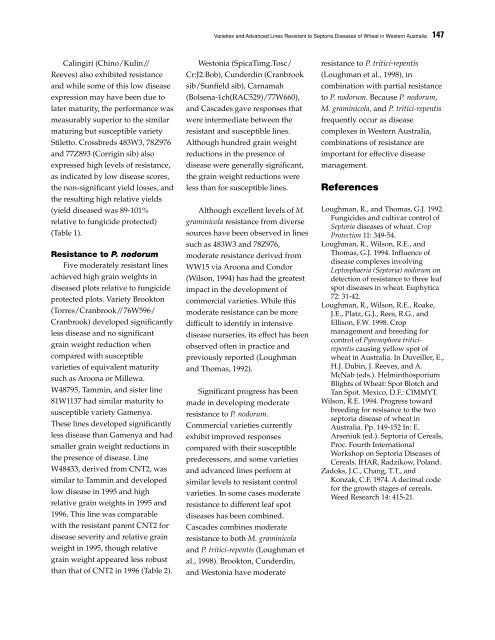Septoria and Stagonospora Diseases of Cereals - CIMMYT ...
Septoria and Stagonospora Diseases of Cereals - CIMMYT ...
Septoria and Stagonospora Diseases of Cereals - CIMMYT ...
Create successful ePaper yourself
Turn your PDF publications into a flip-book with our unique Google optimized e-Paper software.
Calingiri (Chino/Kulin//<br />
Reeves) also exhibited resistance<br />
<strong>and</strong> while some <strong>of</strong> this low disease<br />
expression may have been due to<br />
later maturity, the performance was<br />
measurably superior to the similar<br />
maturing but susceptible variety<br />
Stiletto. Crossbreds 483W3, 78Z976<br />
<strong>and</strong> 77Z893 (Corrigin sib) also<br />
expressed high levels <strong>of</strong> resistance,<br />
as indicated by low disease scores,<br />
the non-significant yield losses, <strong>and</strong><br />
the resulting high relative yields<br />
(yield diseased was 89-101%<br />
relative to fungicide protected)<br />
(Table 1).<br />
Resistance to P. nodorum<br />
Five moderately resistant lines<br />
achieved high grain weights in<br />
diseased plots relative to fungicide<br />
protected plots. Variety Brookton<br />
(Torres/Cranbrook//76W596/<br />
Cranbrook) developed significantly<br />
less disease <strong>and</strong> no significant<br />
grain weight reduction when<br />
compared with susceptible<br />
varieties <strong>of</strong> equivalent maturity<br />
such as Aroona or Millewa.<br />
W48795, Tammin, <strong>and</strong> sister line<br />
81W1137 had similar maturity to<br />
susceptible variety Gamenya.<br />
These lines developed significantly<br />
less disease than Gamenya <strong>and</strong> had<br />
smaller grain weight reductions in<br />
the presence <strong>of</strong> disease. Line<br />
W48433, derived from CNT2, was<br />
similar to Tammin <strong>and</strong> developed<br />
low disease in 1995 <strong>and</strong> high<br />
relative grain weights in 1995 <strong>and</strong><br />
1996. This line was comparable<br />
with the resistant parent CNT2 for<br />
disease severity <strong>and</strong> relative grain<br />
weight in 1995, though relative<br />
grain weight appeared less robust<br />
than that <strong>of</strong> CNT2 in 1996 (Table 2).<br />
Varieties <strong>and</strong> Advanced Lines Resistant to <strong>Septoria</strong> <strong>Diseases</strong> <strong>of</strong> Wheat in Western Australia 147<br />
Westonia (SpicaTimg.Tosc/<br />
Cr:J2.Bob), Cunderdin (Cranbrook<br />
sib/Sunfield sib), Carnamah<br />
(Bolsena-1ch(RAC529)/77W660),<br />
<strong>and</strong> Cascades gave responses that<br />
were intermediate between the<br />
resistant <strong>and</strong> susceptible lines.<br />
Although hundred grain weight<br />
reductions in the presence <strong>of</strong><br />
disease were generally significant,<br />
the grain weight reductions were<br />
less than for susceptible lines.<br />
Although excellent levels <strong>of</strong> M.<br />
graminicola resistance from diverse<br />
sources have been observed in lines<br />
such as 483W3 <strong>and</strong> 78Z976,<br />
moderate resistance derived from<br />
WW15 via Aroona <strong>and</strong> Condor<br />
(Wilson, 1994) has had the greatest<br />
impact in the development <strong>of</strong><br />
commercial varieties. While this<br />
moderate resistance can be more<br />
difficult to identify in intensive<br />
disease nurseries, its effect has been<br />
observed <strong>of</strong>ten in practice <strong>and</strong><br />
previously reported (Loughman<br />
<strong>and</strong> Thomas, 1992).<br />
Significant progress has been<br />
made in developing moderate<br />
resistance to P. nodorum.<br />
Commercial varieties currently<br />
exhibit improved responses<br />
compared with their susceptible<br />
predecessors, <strong>and</strong> some varieties<br />
<strong>and</strong> advanced lines perform at<br />
similar levels to resistant control<br />
varieties. In some cases moderate<br />
resistance to different leaf spot<br />
diseases has been combined.<br />
Cascades combines moderate<br />
resistance to both M. graminicola<br />
<strong>and</strong> P. tritici-repentis (Loughman et<br />
al., 1998). Brookton, Cunderdin,<br />
<strong>and</strong> Westonia have moderate<br />
resistance to P. tritici-repentis<br />
(Loughman et al., 1998), in<br />
combination with partial resistance<br />
to P. nodorum. Because P. nodorum,<br />
M. graminicola, <strong>and</strong> P. tritici-repentis<br />
frequently occur as disease<br />
complexes in Western Australia,<br />
combinations <strong>of</strong> resistance are<br />
important for effective disease<br />
management.<br />
References<br />
Loughman, R., <strong>and</strong> Thomas, G.J. 1992.<br />
Fungicides <strong>and</strong> cultivar control <strong>of</strong><br />
<strong>Septoria</strong> diseases <strong>of</strong> wheat. Crop<br />
Protection 11: 349-54.<br />
Loughman, R., Wilson, R.E., <strong>and</strong><br />
Thomas, G.J. 1994. Influence <strong>of</strong><br />
disease complexes involving<br />
Leptosphaeria (<strong>Septoria</strong>) nodorum on<br />
detection <strong>of</strong> resistance to three leaf<br />
spot diseases in wheat. Euphytica<br />
72: 31-42.<br />
Loughman, R., Wilson, R.E., Roake,<br />
J.E., Platz, G.J., Rees, R.G., <strong>and</strong><br />
Ellison, F.W. 1998. Crop<br />
management <strong>and</strong> breeding for<br />
control <strong>of</strong> Pyrenophora triticirepentis<br />
causing yellow spot <strong>of</strong><br />
wheat in Australia. In Duveiller, E.,<br />
H.J. Dubin, J. Reeves, <strong>and</strong> A.<br />
McNab (eds.). Helminthosporium<br />
Blights <strong>of</strong> Wheat: Spot Blotch <strong>and</strong><br />
Tan Spot. Mexico, D.F.: <strong>CIMMYT</strong>.<br />
Wilson, R.E. 1994. Progress toward<br />
breeding for resisance to the two<br />
septoria disease <strong>of</strong> wheat in<br />
Australia. Pp. 149-152 In: E.<br />
Arseniuk (ed.). <strong>Septoria</strong> <strong>of</strong> <strong>Cereals</strong>,<br />
Proc. Fourth International<br />
Workshop on <strong>Septoria</strong> <strong>Diseases</strong> <strong>of</strong><br />
<strong>Cereals</strong>. IHAR, Radzikow, Pol<strong>and</strong>.<br />
Zadoks, J.C., Chang, T.T., <strong>and</strong><br />
Konzak, C.F. 1974. A decimal code<br />
for the growth stages <strong>of</strong> cereals.<br />
Weed Research 14: 415-21.









